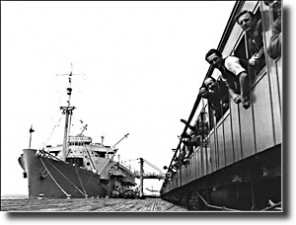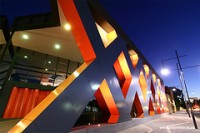Displaced people
Loss, hope, and disruption mark the psyche of the ‘immigrant’, whatever their personal circumstances. As I entered Melbourne’s Immigration Museum and sought out the gallery dedicated to the mid 20th century exodus from Europe following the Second World War, I saw my father’s story beaming at me from the walls. For a few minutes I was transported from a gallery in downtown Melbourne into a vortex of emotion and memory bound up in the conflated history of my own and my father’s sense of displacement.

Displaced People (DPs) arrive in Australia
They were actually called ‘displaced persons’ or ‘DPs’, these mainly Eastern European refugees who arrived in Australia by the boatload from the late 1940s to the mid 1950s. Where they ended up immediately after the war was inhospitable or unworkable for them due to economic collapse, unstable government or mass unemployment. As ‘displaced’ people, returning to their own country of origin would have meant torture, incarceration or death. In my father’s case, it would probably have meant immediate deportation to a gulag in Siberia. The Australian government offered free passage and citizenship to DPs in exchange for indentured labour and, because of the White Australia policies of the time, it privileged people from countries it considered to be more consonant with white Australian values and racial characteristics, particularly those from the Baltic States.
An Estonian citizen, although half Finnish, my father chose to fight with the Finns against the Soviet Union, which was bearing down on Finland’s western front from 1939 onwards. The feisty Finns refused to sign a mutual assistance treaty in Russia’s favour and there was hell to pay. Known as the Suomi Boys, these Estonian men were unable to return to their families, businesses and homeland after the war thanks to the perfidious deal struck between Germany and Russia in 1939 , known as the Ribbentrop Molotov Pact , which effectively carved up Eastern Europe between the two erstwhile enemies. The Baltic States fell to Russia and a reign of terror ensued.
All of these hazy fragments – bower bird like facts, half-remembered stories, osmotic memories garnered from my travels and sporadic encounters with my father while he was alive – came bubbling to the surface of my consciousness as I walked through the post war migration gallery. I saw photos of displaced people arriving in Australia on big boats with names like Wooster Victory (my father’s ship) or Bundy or Derna Voyage or the infamous Dunera. Once they arrived in Australia they were usually farmed out to migrant hostels where they stayed until their debt to the government had been erased. Huge post-war nation building schemes, like the Snowy Mountains Hydo-Electric Scheme, soaked up this ready pool of skilled labour.
The Immigration Museum has a whole gallery devoted to one of the larger migrant hostels, Bonegilla, which was located in Albury-Wodonga on the border between New South Wales and Victoria. Looking at objects retrieved from Bonegilla and watching short interviews with people who had once lived there, made me wonder where my father had been based. Was it Bonegilla? He was indentured to the NSW railways for two years and it was while working on the lines near Henty, my mother’s home town, that he spied my attractive and vivacious mother, and applied his European charm to the task of courting and eventually marrying her. Henty is located half way between Albury and Wagga Wagga.

Albury LibraryMuseum
After a recent visit to the wonderful Albury LibraryMuseum, I found the answer to my question. The LibraryMuseum specialises in Bonegilla resources, artifacts and oral histories. The director, Bridget Guthrie, is justifiably proud of the emphasis given to Bonegilla and the impact post war immigration has bequeathed to the Albury-Wodonga region. After my meeting with Bridget, I drove to Henty to have afternoon tea with my great aunt Joyce, my aunt Helen and uncle Ron. I casually asked whether they knew if my father, Kaarel, has been a resident of Bonegilla or another migrant camp in Uranquinty. Bonegilla, of course, Joyce and Helen proclaimed in unison. “But your father slept in an old tent while he was working on the railway tracks near Henty,” said Helen. “And he never complained once, he was just so relieved to be in Australia – especially when he met your mother!”
The chaos of war, the leaky and crowded old ships carrying their human cargo to a destination signifying new life, a vast old hot unreceptive continent, a fibro hostel that used to be an old army camp, a tent in the sweltering heat and bitter inland winters – enduring all that takes sisu.


